Author: Yash Agarwal Source: medium Translation: Shan Ouba, Golden Finance
The chief technology officer of A16z recently argued that memecoins are "not attractive to builders" and "may even be a net negative if externalities are taken into account."
He described memecoins as "a series of false promises covering up a casino," "changing the way the public, regulators, and entrepreneurs view cryptocurrencies," and "technically uninteresting," among other things.
Meanwhile, Chris Dixon published a more sober article on the subject, highlighting the systemic absurdity of the U.S. securities law system - emphasizing that the best projects were stuck in regulatory deadlock, while memecoins ultimately survived because they "didn't pretend that memecoin investors were dependent on anyone's stewardship." This implicitly acknowledges the charade (pretend behavior) of the rest of the crypto space — various teams do management work for protocols, while we call them governance tokens.
Our goal is neither to defend memecoins (or governance tokens) nor to disparage them; just to advocate for fairer ways of issuing tokens.
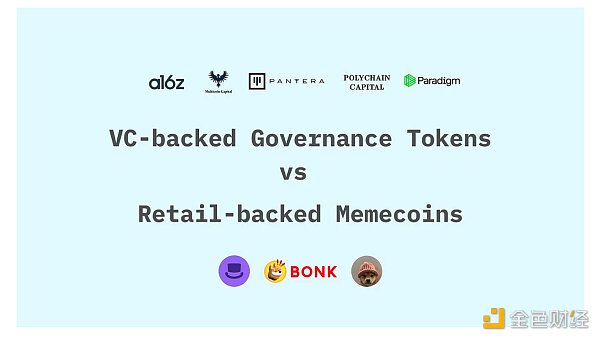
Governance Tokens Are Memecoins With Extra Steps
I believe that all governance tokens are essentially memecoins, whose value is determined by the memetic origins of the protocol. In other words, governance tokens are memecoins in suits. Why?
Typically, governance tokens don’t offer any revenue sharing (due to security laws), and they don’t work particularly well as community-facing decision-making frameworks (holdings tend to be concentrated, participation is apathetic, or DAOs are often dysfunctional) — with the extra steps to make them as useful as memecoins. Whether it’s ARB (Arbitrum’s governance token) or WLD (Worldcoin’s token) — they’re essentially memecoins attached to these projects.
This isn’t to say that governance tokens don’t have their uses. Ultimately, their existence is a constant reminder of why the law needs an update. That said, governance tokens can cause as much harm as memecoins in many cases:
For builders: Many governance tokens backed by well-known VCs have launched before a product has been released, causing massive disillusionment. This directly damages the credibility of founders who have been working hard for years to gain adoption. For example, Zeus Network launched with $1B FDV before launching a product, while many founders have difficulty reaching such valuations even after achieving significant traction.
For the community: Most governance tokens are VC-backed tokens, issued at high valuations and sold off to retail investors over time.
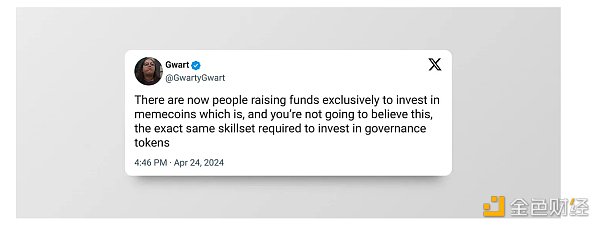
Looking at projects like ICP, XCH, Apecoin, DFINITY, and even the ICOs from 2017 are preferable to the current VC-backed low-circulation tokens as they are fairer with most of the supply unlocked at launch.
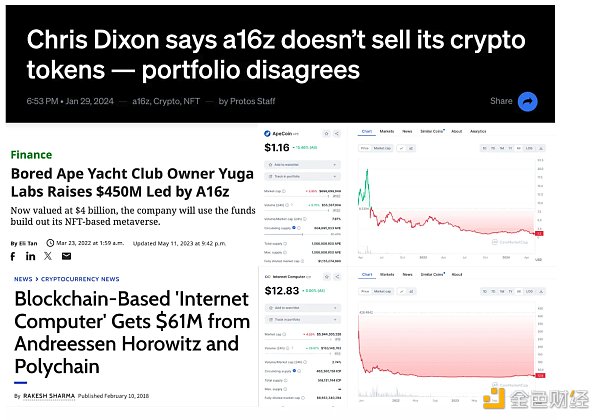
Let’s look at the example of EigenLayer:
EigenLayer is arguably one of the largest Ethereum protocols in this cycle, and a classic example. Insiders (VCs and the team) hold a large portion of tokens, accounting for 55%, while the initial community airdrop only accounted for 5%. This is a classic low circulation, high fully diluted valuation (FDV) play, backed by VCs who hold 29.5%. Last cycle, we blamed FTX/Alameda, but this cycle is no better.
EIGENDAO is governed by the EIGEN token, which now looks no different than any Web2 governance committee, as insiders control the majority of the supply (the community supply was initially only 5%). Not to mention, the entire concept of EigenLayer is rehypothecation (leveraged yield farming), which makes its financial engineering as much of a Ponzi scheme as memecoins.
If a group of insiders take more than half of the supply (55% in this case), then we are severely hindering the redistributive effect of cryptocurrency and making a few insiders rich through a low circulation, high FDV launch. If insiders are really confident, then they would be better off taking less allocations given that the valuations of the token launch are already ridiculously high.
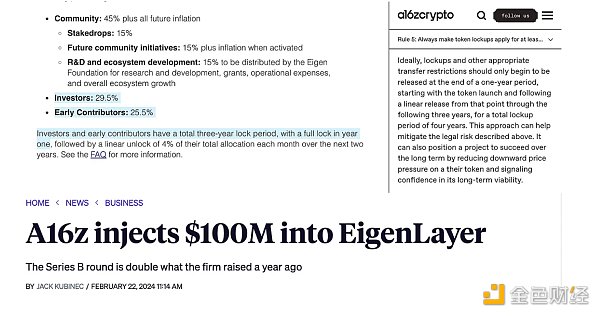
If a group of insiders take up more than half of the supply (55% in this case), we will severely hinder the redistribution effect of cryptocurrency and make a few insiders extremely rich through low circulation, high FDV issuance. If insiders really believe that, given the astronomical valuations of token issuance, they'd better reduce their distribution.
The real mastermind please come forward?
Given the absurdity of the capital formation process, it ultimately leads to VCs blaming memes and meme creators, and meme creators blaming VCs, leaving the entire space in a quagmire of regulatory chaos and serious reputational damage to serious builders.
But why are VCs so harmful to tokens?
VCs have structural reasons to inflate FDVs. For example, a large VC fund invests $4 million for 20% at a price of $20 million; logically, in order for their limited partners (LPs) to benefit, they must increase the FDV to at least $400 million at the token generation event (TGE). Protocols are pushed to the highest possible FDV to increase the value of seed/seed investor tokens.
In the process, they continually encourage projects to raise funding rounds at higher valuations. The larger the fund, the more likely they are to give the project an absurdly high private valuation, build a strong narrative, and ultimately issue tokens at an even higher public valuation, forcing retail investors to sell when the token is issued. Issuing at a high FDV only leads to a downward spiral and zero market awareness. Research Starkware.
Issuing at a lower FDV allows retail investors to profit from repricing and helps form community and market awareness. Research Celestia.

Retail investors are more concerned about token unlocking than ever before. In May alone, Pyth will unlock $1.25 billion in tokens, and projects such as Avalanche, Aptos, Arbitrum, etc. will also unlock hundreds of millions of tokens. Please visit tokens.unlock.app to view all upcoming tokens.
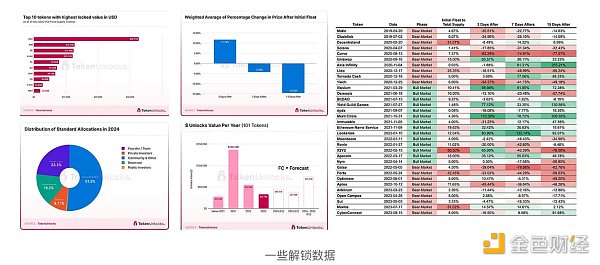
MemeCoin is a product of the collapse of the financial system
It can be said that Bitcoin is the largest and oldest meme coin, which was born after the financial crisis in 2008. Negative/zero interest rates (interest rate - inflation) forced every saver to speculate in new hot asset classes (e.g., meme coins). The zero interest rate environment has created a market full of zombie companies that are living off a steady stream of cheap capital. Even top indices like the S&P 500 contain about 5% zombie companies, and with interest rates now rising, these companies are about to deteriorate into meme coins. To make matters worse, these zombie companies are being recommended by fund managers and retail investors are buying them every month.
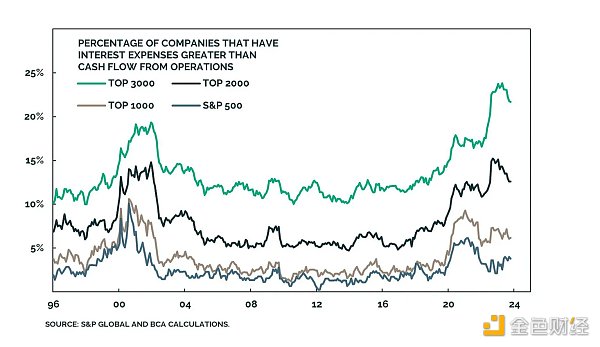
There is a reason why speculation never dies. For this cycle, they are meme coins.
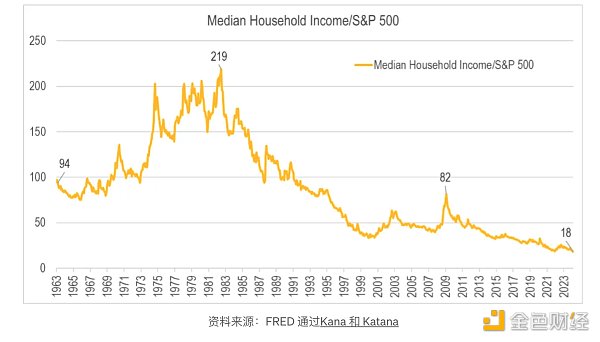
Against this backdrop, the term “financial nihilism” has gained a lot of attention recently. It encapsulates the idea that the cost of living is killing most Americans, that upward mobility is out of reach for more and more people, that the American Dream is largely a thing of the past, and that the ratio of median home price to median household income is at a completely unsustainable level. The underlying drivers of financial nihilism are the same as those of populism, a political tendency that caters to ordinary people who are fed up with the established elites — “this system doesn’t work for me, so I want to try something very different” (e.g., buying BODEN tokens instead of voting for Biden).
Memcoins are stress testing infrastructure:
Memcoins are not only a great tool for attracting new people to crypto, but they are also a great way to test infrastructure. We believe that, contrary to A16z’s position, memecoins have a net positive impact on any ecosystem. Without memecoins, blockchains like Solana would not face network congestion issues, nor would all network/economic vulnerabilities be discovered. Memecoins on Solana are generally positive:
All decentralized exchanges (DEXs) not only processed all-time high volumes, but also surpassed their counterparts on Ethereum.
Currency markets integrate memecoins to increase total value locked (TVL).
Consumer applications integrate memecoins to gain attention or for marketing purposes.
Validators earn huge fees due to priority fees and Maximum Extractable Value (MEV).
Broader network effects in the DeFi space due to increased liquidity and activity.
There’s a reason Solana’s wallet Phantom has 7M monthly active devices (driven by memecoins attracting regular users to join) - it’s probably one of the most used applications in crypto right now.
For serious decentralized real-world assets (RWAs) to trade on-chain, we need to have liquidity (check out the top memecoins; they have the deepest liquidity outside of L1 tokens/stablecoins), stress-tested DEXs, and broader DeFi infrastructure. Memecoins are not a distraction; they’re just another asset class that exists on a shared ledger.

Memcoin as a financing mechanism:
Memcoin has now been proven to be an effective means of capital coordination. Research Pump.fun, which has facilitated the issuance of close to millions of memecoins and created billions of dollars in value for memecoins. Why? Because for the first time in human history, anyone can create a financial asset in less than $2 and 2 minutes!
Memecoins can also be a doskona (doskona is Portuguese, meaning "perfect" or "excellent") fundraising mechanism and go-to-market strategy. Traditionally, projects raise large amounts of money by allocating 15-20% to venture capitalists (VCs), developing products, and then issuing tokens while building communities through memes and marketing. However, this often results in communities being abandoned by VCs in the end.
In the memecoin era, people can raise funds by issuing their memecoin (no roadmap, just for fun) and forming a tribal community early on. They can then continue to build applications/infrastructure, constantly adding utility to the memecoin without making false promises or providing a roadmap. This approach leverages the tribalism of the memecoin community (bagholder bias - a psychological state that refers to the tendency of people holding a large amount of losing assets to underestimate their losses and overestimate their rebound potential) and ensures high engagement of community members who will become your business development/marketing personnel. It also ensures a fairer distribution of tokens, countering the low circulation, high fully diluted valuation (FDV) pump and dump strategies employed by VCs.
This is already happening:
1.BONKBot is a Telegram bot derived from the BONK meme coin (peak daily trading volume of $250 million), which uses 10% transaction fees to buy and destroy BONK. It has cumulatively destroyed about $7 million of BONK through fees alone, thus aligning its economics with holders.
2. Degen, a meme coin in the Farcaster ecosystem, allows publishers to reward/tip people who publish quality content with DEGEN. In addition, they have built an L3 chain for decentralized applications (DeFi). Similarly, Shibatoken, one of the most popular meme coins in the last cycle, is now building an L2.
This trend will eventually lead to the convergence of memecoins and governance tokens. It is important to note that not all memecoins are equal, and scams are common, but they are easier to uncover than frauds quietly perpetrated by VCs.
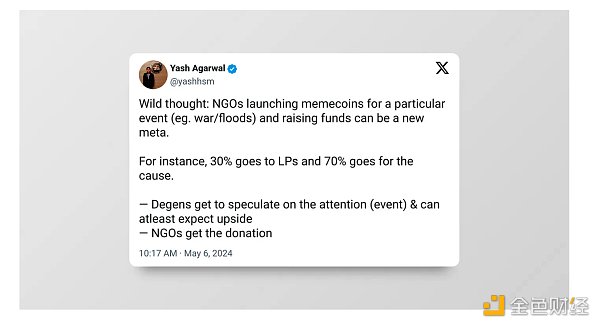
Future Outlook
Everyone wants to get in on the next big thing as early as possible, and memecoins are one of the few areas where retail investors can get involved earlier than most institutions. Due to the threshold restrictions of venture capital (VC) private transactions, memecoins provide better potential market fit for retail funds. While memecoins give power back to the community, they do make crypto look like a casino.
So, what’s the solution? VCs like a16z should syndicate their deals and allow anyone to participate. Platforms like Echo are perfect for this.
Advice to VCs: Put your deals on Echo, let the community participate in syndicating deals, and witness the magic of memecoin-like communities rallying from the early days of a project.
To clarify, we are not against VC/private funding; we are for fairer distribution, leveling the playing field, and giving everyone a chance at financial autonomy. VCs should be rewarded for their early risk-taking. Crypto is not just about open and permissionless technology; it’s about making early-stage funding, which is currently just as opaque as traditional startups, more public and transparent.
Summary:
1. Everything can be a meme coin
2. Research meme coins as a fundraising and community building mechanism
3. Projects should tend to be more equitable
It’s time to make early financing more open.
 JinseFinance
JinseFinance











